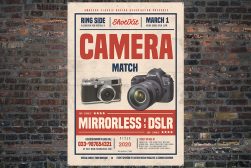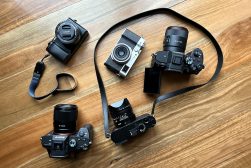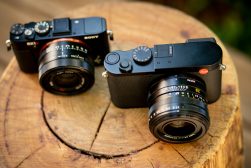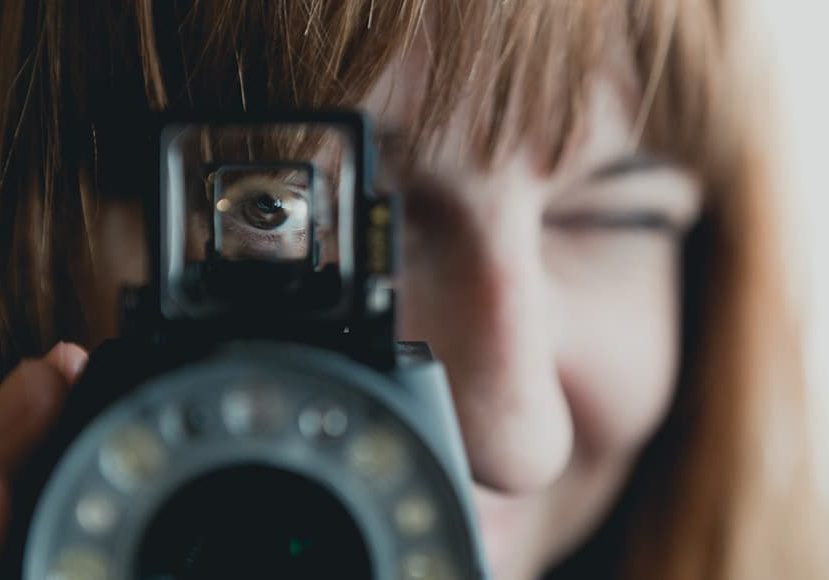
What Is a Viewfinder and How Is It Used?
Discover everything you need to know about the camera viewfinder, including the difference between an OVF and EVF, and 13 FAQs on how best to use one.
Learn | Photography Guides | By Ana Mireles
This is a guide to the viewfinder, a small glass rectangle found on top of your camera.
Every film camera and DSLR has a viewfinder, as do the majority of mirrorless and film cameras.
(Compact cameras with viewfinders are rarer, though they do exist.)
The viewfinder is your window to the world as a photographer – despite advancements in camera technology, the humble viewfinder remains relatively unchanged.
Let’s have a closer look at all the most common beginners’ questions surrounding the viewfinder here in 2023.
Table of Contents
What is a Viewfinder?

On most cameras, the viewfinder sits at the top.
A viewfinder is the part of the camera you look through to frame and compose your photo. Normally it’s placed on the bump on top of the camera.
There are two types of viewfinders: optical (OVF) or electronic (EVF).
What is an Electronic Viewfinder?
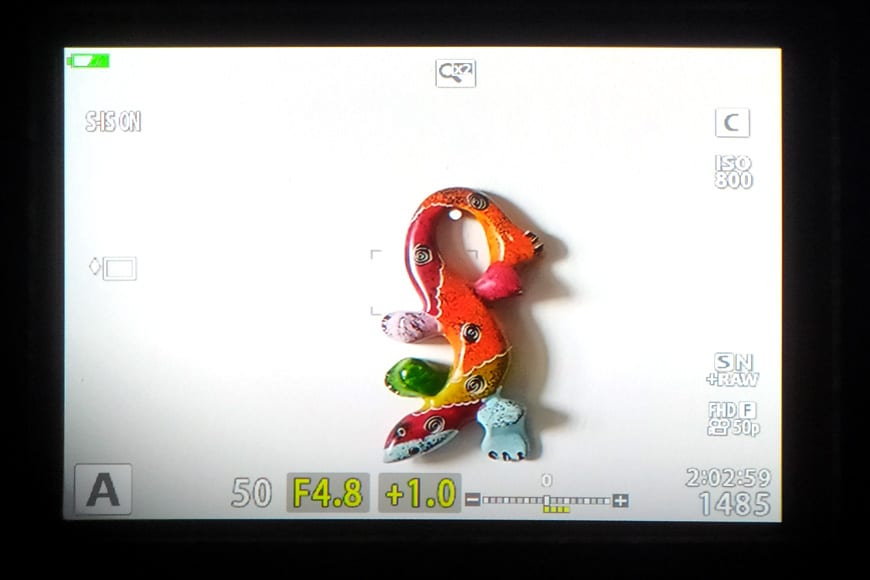
EVFs show you a live view of the image in front of your lens.
An electronic viewfinder is a small display that shows the scene you have in front of the camera. With an electronic viewfinder (EVF), you can see exactly what your sensor sees.
This means that you have a live version of the image you’re about to shoot. If you change the settings, the exposure changes on the viewfinder before you take the picture.
With some cameras, you can connect an external camera screen (see our guide) which mimics the EVF’s display, allowing you to see fine details and colours even clearer.
Pros:
- You have all the information you need to focus, frame and expose your image. In some cameras, you even have a live histogram.
- Any changes you make are shown live on the viewfinder.
Cons:
- These viewfinders consume part of your battery life.
- There is a refresh rate that can cause a time lag.
What is an Optical Viewfinder?
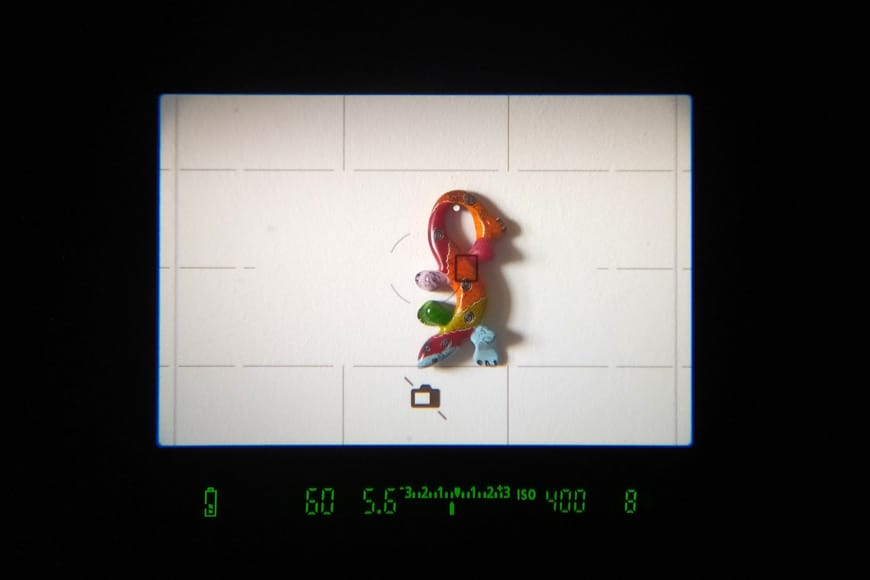
OVFs use mirrors and prisms to show you what the camera’s lens is seeing.
Optical viewfinders (OVF) are built by a system of mirrors and prisms that allow you to see what the lens of the camera is seeing.
With optical viewfinders, the image may be different from the view because you’re not seeing the effect of the settings. In other words, if you change camera settings like aperture or shutter speed, it won’t be reflected in the viewfinder.
They display the settings information and focus points though, so you don’t have to take your eye off the viewfinder while focusing and taking your shot.
Pros:
- It’s an unaltered view of the real scene.
- They don’t use any of your battery.
Cons:
- When you take the picture, the mirror goes up, and you get a blank view on the viewfinder.
- You don’t get to see how the final photo will look like before taking it.
How does a viewfinder work?
- Optical viewfinder
When the light comes in through the lens, it hits a mirror that sits in front of the sensor. Thanks to the angle of the mirror, the light bounces up towards a pentaprism. Here it’s directed towards the eyepiece to show the scene in front of the lens.
- Electronic viewfinder
When the light comes in, the sensor registers and processes the scene, which then sends it to the electronic viewfinder’s small display. Because it’s an electronic representation, you can see the exposure settings live.
Is a viewfinder important?
It depends on the type of photography that you do, but the general answer would be yes. We’re getting used to taking a picture using only an LCD screen because of our smartphone cameras. However, in most situations, a viewfinder will help you improve your framing and composition.
When you look through the viewfinder on a DSLR, what are you seeing?
Most DSLR cameras have an optical viewfinder. That means that you see the same thing as your lens, which means that it’s not affected by the exposure settings.
Keep in mind that you can only see 90-95% of the scene through a viewfinder – losing the borders of the image.
Is an optical viewfinder better than an electronic viewfinder?
Each type of viewfinder has its pros and cons; choosing one over another depends on your needs and preferences.
For example, if you shoot sports photography, you might find optical viewfinders better. This is because there’s no time lag in the OVF.
However, if you do a lot of photography in low light situations, the electronic viewfinder may be better because it offers a brightness increase.
Why do photographers look through the viewfinder?
Photographers look through the viewfinder to get a better view of what they are shooting. For example, when you’re shooting on a bright sunny day, you can’t see many details on the LCD screen.
Which eye do you look through the viewfinder with?
Normally, photographers use their dominant eye. That’s to say that a right-handed photographer will look through the viewfinder with the right eye, and a left-handed photographer will use the left eye. Of course, you’re welcome to use whichever one you prefer.
Can I add a viewfinder to my camera?
Yes, you can buy an external viewfinder for your camera. There are electronic and optical viewfinders on the market, and they can be attached to your camera via the hot shoe.
What is the difference between a viewfinder and an LCD screen?
The main difference between viewfinders and LCD screens is in the way you see the scene that’s in front of you. On the LCD screen, you can see a digital representation of it, like looking at the tv.
With an optical viewfinder, you’re seeing things through a piece of glass – it can be compared to looking through a window or a pair of binoculars.
Also, with a viewfinder (both OVF and EVF) you don’t have to deal with glare, you have a steadier hold of the camera, and you get better peripheral vision when you shoot.
What is the point of a viewfinder?
The viewfinder helps you to frame and compose in the best possible way. Many photographers can’t live without a viewfinder on their camera, whether it’s electronic or optical.
Do mirrorless cameras have a viewfinder?
It depends on the camera brand and model. Most entry-level mirrorless cameras don’t have a viewfinder. However, if you can spend a little bit more, you’ll find mirrorless cameras with built-in electronic viewfinders.
Final Words
Hopefully, this article cleared up some of your doubts about viewfinders and how they can be used to take the possible image with your camera – whether it be analogue or digital.
I know it’s a lot of information and it can be confusing, so if you have any other questions about viewfinders, feel free to post them in the comments section below.





